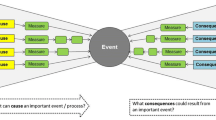Abstract
The design of a public-private flood insurance system is a multi-stakeholder policy problem. The stakeholders include, among others, the public in the high-risk and low-risk areas, the insurance companies and the government. With an understanding of the preferences of the stakeholder groups, decision analysis can be a useful tool in establishing and ranking different policy alternatives. However, the design of a nation-wide insurance system involves handling imprecise information, including estimates of the stakeholders’ utilities, outcome probabilities and importance weightings. This chapter describes a general approach to analysing decision situations under risk involving multiple stakeholders. The approach was employed to assess options for designing a public-private flood insurance and reinsurance system in Hungary with a focus on the Tisza river basin. It complements the actual stakeholder process for this same purpose described in previous chapters of this book. The general method of probabilistic, multi-stakeholder analysis extends the use of utility functions for supporting evaluation of imprecise and uncertain information.
Access this chapter
Tax calculation will be finalised at checkout
Purchases are for personal use only
Similar content being viewed by others
Notes
- 1.
The scales are from the lowest value to the highest value on the y-axes.
References
Brouwers L, Danielson M, Ekenberg L, Hansson K (2004) Multi-criteria decision-making of policy strategies with public-private re-insurance systems. Risk Decis Policy 9(1):23–45
Brouwers L, Riabacke M (2012) Consensus by simulation: a flood model for participatory policymaking. In: Amendola et al. (eds) Integrated catastrophe risk modeling: supporting policy processes. Springer, Dordrecht, pp xx–xx
IPCC (2001) In: Houghton JT, Ding Y, Griggs DJ, Noguer M, van der Linden PJ, Dai X, Maskell K, Johnson CA (eds) Climate change 2001: the scientific basis. Contribution of working group I to the third assessment report of the intergovernmental panel on climate change. Cambridge University Press, Cambridge, UK/New York, 881 pp
Danielson M (2004) Handling imperfect user statements in real-life decision analysis. Int J Inf Technol Decis Mak 3(3):513–534
Danielson M, Ekenberg L (2007) Computing upper and lower bounds in interval decision trees. Eur J Oper Res 181:808–816
Danielson M, Ekenberg L, Johansson J, Larsson A (2003) The DecideIT decision tool, ISIPTA '03. In: Bernard J-M, Seidenfeld T, Zaffalon M (eds) Proceedings of the 3rd international symposium on imprecise probabilities and their applications, proceedings in informatics 18, Carleton Scientific, pp 204–217
Danielson M, Ekenberg L, Ekengren A, Hökby T, Lidén J (2008) A process for participatory democracy in electronic government. J Multi-Criteria Decis Anal 15(1–2):15–30
Ekenberg L (2000) Risk constraints in agent based decisions. In: Kent A, Williams JG (eds) Encyclopaedia of computer science and technology 23(48):263–280, Marcel Dekker Inc.
Ekenberg L, Thorbiörnson J (2001) Second-order decision analysis. Int J Uncertain Fuzziness Knowl-Based Syst 9(1):13–38
Ekenberg L, Boman M, Linnerooth-Bayer J (2001) General risk constraints. J Risk Res 4(1):31–47
Ekenberg L, Thorbiörnson J, Baidya T (2005) Value differences using second order distributions. Int J Approx Reason 38(1):81–97
Jiménez A, Rios-Insua S, Mateos A (2006) A generic multi-attribute analysis system. Comput Oper Res 33(4):1081–1101
Larsson A, Johansson J, Ekenberg L, Danielson M (2005) Decision analysis with multiple objectives in a framework for evaluating imprecision international. J Uncertain Fuzziness Knowl-Based Syst 13(5):495–510
Salo AA, Hämäläinen RP (1995) Preference programming through approximate ratio. Comp Eur J Oper Res 82:458–475
Vári A (1999) Flood control development in Hungary: public awareness report. Prepared for VITUKI consult Rt Budapest: Hungarian Academy of Sciences Institute of Sociology
Author information
Authors and Affiliations
Corresponding author
Editor information
Editors and Affiliations
Rights and permissions
Copyright information
© 2013 Springer Science+Business Media Dordrecht
About this chapter
Cite this chapter
Danielson, M., Ekenberg, L. (2013). A Risk-Based Decision Analytic Approach to Assessing Multi-stakeholder Policy Problems. In: Amendola, A., Ermolieva, T., Linnerooth-Bayer, J., Mechler, R. (eds) Integrated Catastrophe Risk Modeling. Advances in Natural and Technological Hazards Research, vol 32. Springer, Dordrecht. https://doi.org/10.1007/978-94-007-2226-2_14
Download citation
DOI: https://doi.org/10.1007/978-94-007-2226-2_14
Published:
Publisher Name: Springer, Dordrecht
Print ISBN: 978-94-007-2225-5
Online ISBN: 978-94-007-2226-2
eBook Packages: Earth and Environmental ScienceEarth and Environmental Science (R0)




